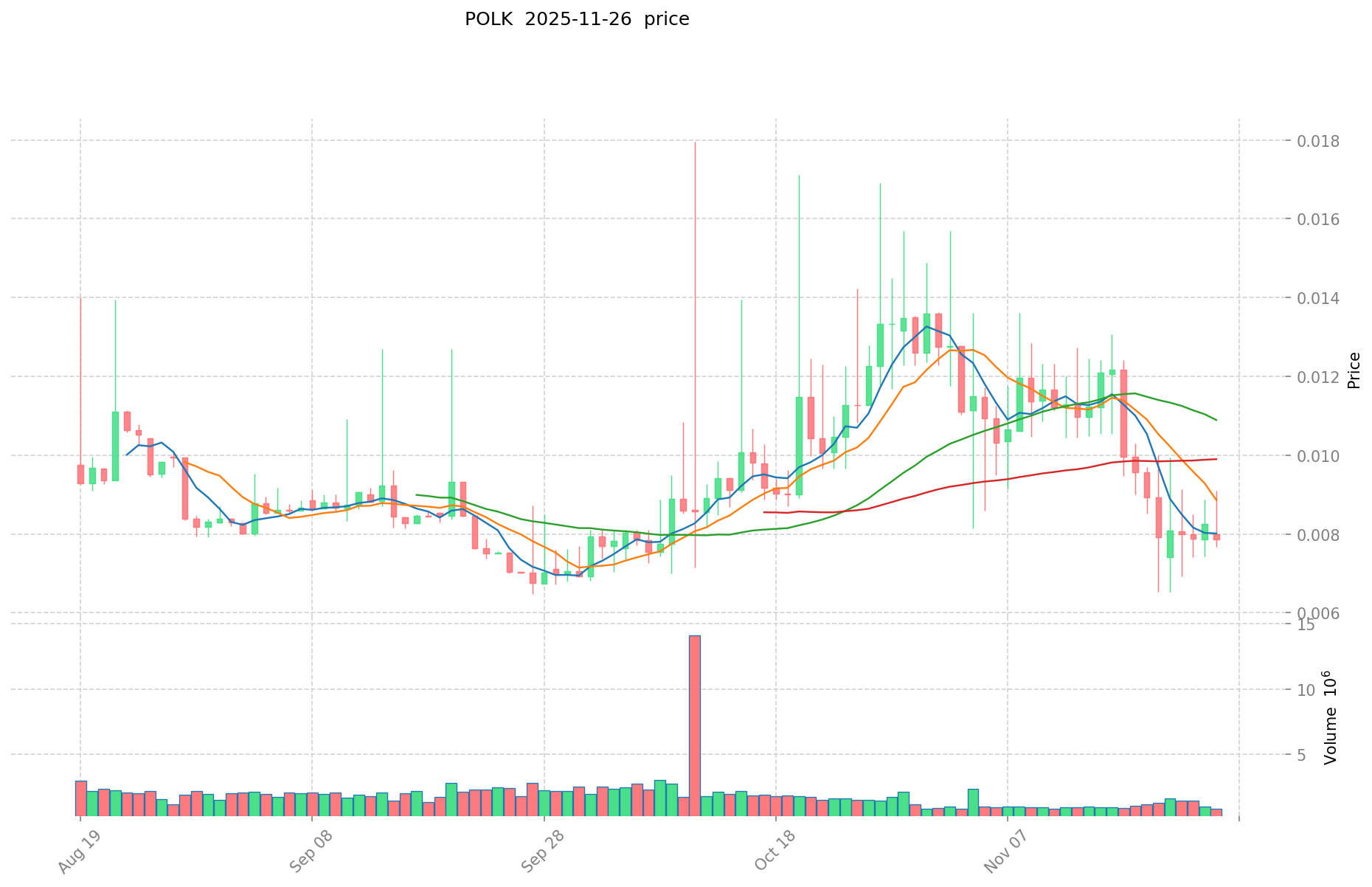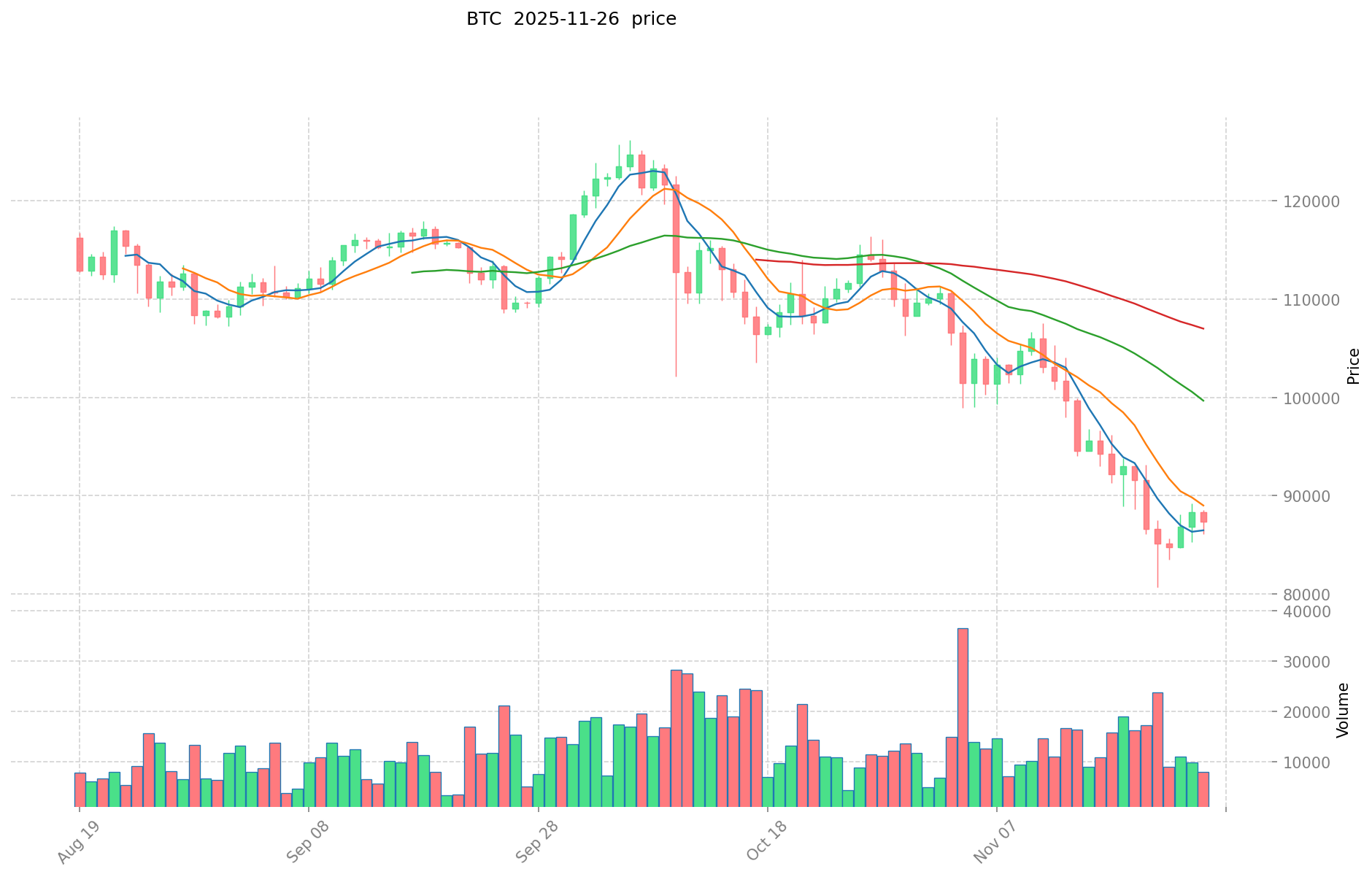POLK vs BTC: Comparing the Performance and Potential of Two Crypto Assets
Introduction: POLK vs BTC Investment Comparison
In the cryptocurrency market, the comparison between Polkamarkets (POLK) vs Bitcoin (BTC) has always been an unavoidable topic for investors. The two not only have significant differences in market cap ranking, application scenarios, and price performance, but also represent different positioning in crypto assets.
Polkamarkets (POLK): Since its launch in 2021, it has gained market recognition for its cross-chain information exchange and prediction market capabilities.
Bitcoin (BTC): Since its inception in 2008, it has been hailed as "digital gold" and is one of the cryptocurrencies with the highest global trading volume and market capitalization.
This article will provide a comprehensive analysis of the investment value comparison between POLK and BTC, focusing on historical price trends, supply mechanisms, institutional adoption, technological ecosystems, and future predictions, attempting to answer the question investors care about most:
"Which is the better buy right now?"
I. Price History Comparison and Current Market Situation
POLK (Coin A) and BTC (Coin B) Historical Price Trends
- 2021: POLK reached its all-time high of $4.18 on March 16, 2021, likely due to increased interest in prediction markets and DeFi platforms.
- 2021: BTC hit its previous all-time high of $64,863 on April 14, 2021, driven by institutional adoption and mainstream acceptance.
- Comparative analysis: In the current market cycle, POLK has declined from its ATH of $4.18 to a current price of $0.007691, while BTC has shown more resilience, currently trading at $87,234.9 after reaching a new ATH of $126,080 on October 7, 2025.
Current Market Situation (2025-11-26)
- POLK current price: $0.007691
- BTC current price: $87,234.9
- 24-hour trading volume: POLK $8,959.39 vs BTC $862,183,506.85
- Market Sentiment Index (Fear & Greed Index): 20 (Extreme Fear)
Click to view real-time prices:
- Check POLK current price Market Price
- Check BTC current price Market Price


II. Core Factors Affecting POLK vs BTC Investment Value
Supply Mechanism Comparison (Tokenomics)
- POLK: Limited supply of 10 billion tokens, with specific allocations for team, investors, ecosystem, etc.
- BTC: Fixed maximum supply of 21 million coins with halving mechanism every 4 years
- 📌 Historical Pattern: Bitcoin's halving events have historically triggered bull markets, while POLK's tokenomics are still unproven in market cycles.
Institutional Adoption and Market Applications
- Institutional Holdings: Bitcoin has significant institutional adoption from companies like MicroStrategy, Tesla, and through ETFs, while POLK lacks major institutional backing.
- Enterprise Adoption: Bitcoin serves as a treasury asset and settlement layer, while POLK's enterprise applications remain limited.
- National Policies: Bitcoin has gained legal tender status in countries like El Salvador, while experiencing varied regulatory approaches globally. POLK faces similar regulatory uncertainties.
Technical Development and Ecosystem Building
- POLK Technical Features: Built on Polkadot ecosystem, focusing on decentralized finance infrastructure and interoperability.
- BTC Technical Development: Layer 2 solutions like Lightning Network for scalability, and Taproot upgrade enhancing privacy and smart contract capabilities.
- Ecosystem Comparison: Bitcoin has a more established ecosystem across payments, custody solutions, and financial products, while POLK's ecosystem is still developing within the Polkadot framework.
Macroeconomic Factors and Market Cycles
- Inflation Environment Performance: Bitcoin has demonstrated strong anti-inflation properties as "digital gold," while POLK has insufficient data to evaluate its inflation-resistant qualities.
- Macroeconomic Monetary Policy: Bitcoin shows inverse correlation with dollar strength and sensitivity to interest rate changes, with POLK likely following broader crypto market trends.
- Geopolitical Factors: Bitcoin benefits from increased adoption in countries with currency instability, while POLK's cross-border relevance is still emerging.
III. 2025-2030 Price Prediction: POLK vs BTC
Short-term Prediction (2025)
- POLK: Conservative $0.00653735 - $0.007691 | Optimistic $0.007691 - $0.01130577
- BTC: Conservative $55,970.304 - $87,453.6 | Optimistic $87,453.6 - $116,313.288
Mid-term Prediction (2027)
- POLK may enter a growth phase, with prices expected in the range of $0.00837425113525 - $0.01489964163025
- BTC may enter a bullish market, with prices expected in the range of $101,521.7577738 - $162,881.0619228
- Key drivers: Institutional capital inflow, ETF, ecosystem development
Long-term Prediction (2030)
- POLK: Base scenario $0.011078014494926 - $0.017309397648323 | Optimistic scenario $0.017309397648323 - $0.020598183201504
- BTC: Base scenario $96,592.39030084959315 - $189,396.843727156065 | Optimistic scenario $189,396.843727156065 - $204,548.5912253285502
Disclaimer: This analysis is based on historical data and projections. Cryptocurrency markets are highly volatile and unpredictable. This information should not be considered as financial advice. Always conduct your own research before making investment decisions.
POLK:
| 年份 | 预测最高价 | 预测平均价格 | 预测最低价 | 涨跌幅 |
|---|---|---|---|---|
| 2025 | 0.01130577 | 0.007691 | 0.00653735 | 0 |
| 2026 | 0.01225291665 | 0.009498385 | 0.0087385142 | 23 |
| 2027 | 0.01489964163025 | 0.010875650825 | 0.00837425113525 | 41 |
| 2028 | 0.015722928397702 | 0.012887646227625 | 0.008505846510232 | 67 |
| 2029 | 0.020313507983982 | 0.014305287312663 | 0.007867908021965 | 86 |
| 2030 | 0.020598183201504 | 0.017309397648323 | 0.011078014494926 | 125 |
BTC:
| 年份 | 预测最高价 | 预测平均价格 | 预测最低价 | 涨跌幅 |
|---|---|---|---|---|
| 2025 | 116313.288 | 87453.6 | 55970.304 | 0 |
| 2026 | 121241.29836 | 101883.444 | 98826.94068 | 16 |
| 2027 | 162881.0619228 | 111562.37118 | 101521.7577738 | 27 |
| 2028 | 179760.448682334 | 137221.7165514 | 98799.635917008 | 57 |
| 2029 | 220302.60483744513 | 158491.082616867 | 144226.88518134897 | 81 |
| 2030 | 204548.5912253285502 | 189396.843727156065 | 96592.39030084959315 | 117 |
IV. Investment Strategy Comparison: POLK vs BTC
Long-term vs Short-term Investment Strategy
- POLK: Suitable for investors focused on DeFi and prediction market potential
- BTC: Suitable for investors seeking stability and inflation-hedge properties
Risk Management and Asset Allocation
- Conservative investors: POLK: 5% vs BTC: 95%
- Aggressive investors: POLK: 20% vs BTC: 80%
- Hedging tools: Stablecoin allocation, options, cross-currency portfolios
V. Potential Risk Comparison
Market Risk
- POLK: High volatility, limited liquidity, and market sentiment sensitivity
- BTC: Cyclical price fluctuations, influenced by macroeconomic factors
Technical Risk
- POLK: Scalability, network stability, and ecosystem development challenges
- BTC: Mining centralization, potential security vulnerabilities
Regulatory Risk
- Global regulatory policies have different impacts on both, with BTC facing more scrutiny due to its larger market presence
VI. Conclusion: Which Is the Better Buy?
📌 Investment Value Summary:
- POLK advantages: Cross-chain capabilities, prediction market focus, growth potential within Polkadot ecosystem
- BTC advantages: Established market leader, institutional adoption, proven track record as digital gold
✅ Investment Advice:
- New investors: Consider a small allocation to POLK for diversification, with a larger portion in BTC for stability
- Experienced investors: Balanced approach with higher risk tolerance for POLK, maintaining significant BTC exposure
- Institutional investors: Focus on BTC for regulatory clarity and liquidity, with potential small allocation to POLK for ecosystem exposure
⚠️ Risk Warning: Cryptocurrency markets are highly volatile. This article does not constitute investment advice. None
FAQ
Q1: What are the main differences between POLK and BTC in terms of investment potential? A: POLK is a newer cryptocurrency focused on prediction markets and DeFi within the Polkadot ecosystem, offering higher growth potential but with increased risk. BTC, as the market leader, provides more stability, widespread adoption, and a proven track record as a store of value and inflation hedge.
Q2: How do the supply mechanisms of POLK and BTC compare? A: POLK has a limited supply of 10 billion tokens with specific allocations for various purposes. BTC has a fixed maximum supply of 21 million coins with a halving mechanism every 4 years, which has historically triggered bull markets.
Q3: What is the current market situation for POLK and BTC as of November 26, 2025? A: As of November 26, 2025, POLK is priced at $0.007691 with a 24-hour trading volume of $8,959.39. BTC is priced at $87,234.9 with a 24-hour trading volume of $862,183,506.85. The market sentiment index (Fear & Greed Index) is at 20, indicating extreme fear.
Q4: How do institutional adoption and market applications differ between POLK and BTC? A: BTC has significant institutional adoption from major companies and through ETFs, serving as a treasury asset and settlement layer. POLK lacks major institutional backing and has limited enterprise applications, primarily focusing on its niche within the Polkadot ecosystem.
Q5: What are the long-term price predictions for POLK and BTC by 2030? A: By 2030, POLK's base scenario price range is predicted to be $0.011078014494926 - $0.017309397648323, with an optimistic scenario of $0.017309397648323 - $0.020598183201504. BTC's base scenario price range is predicted to be $96,592.39030084959315 - $189,396.843727156065, with an optimistic scenario of $189,396.843727156065 - $204,548.5912253285502.
Q6: How should investors approach asset allocation between POLK and BTC? A: Conservative investors might consider allocating 5% to POLK and 95% to BTC, while more aggressive investors could allocate 20% to POLK and 80% to BTC. It's important to balance risk and potential returns based on individual investment goals and risk tolerance.
Q7: What are the key risks associated with investing in POLK and BTC? A: POLK faces high volatility, limited liquidity, and ecosystem development challenges. BTC risks include cyclical price fluctuations, mining centralization, and regulatory scrutiny. Both are subject to market sentiment and global regulatory policies, with BTC facing more attention due to its larger market presence.
Share
Content